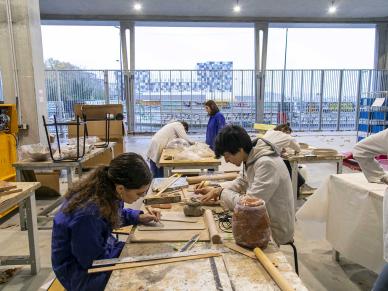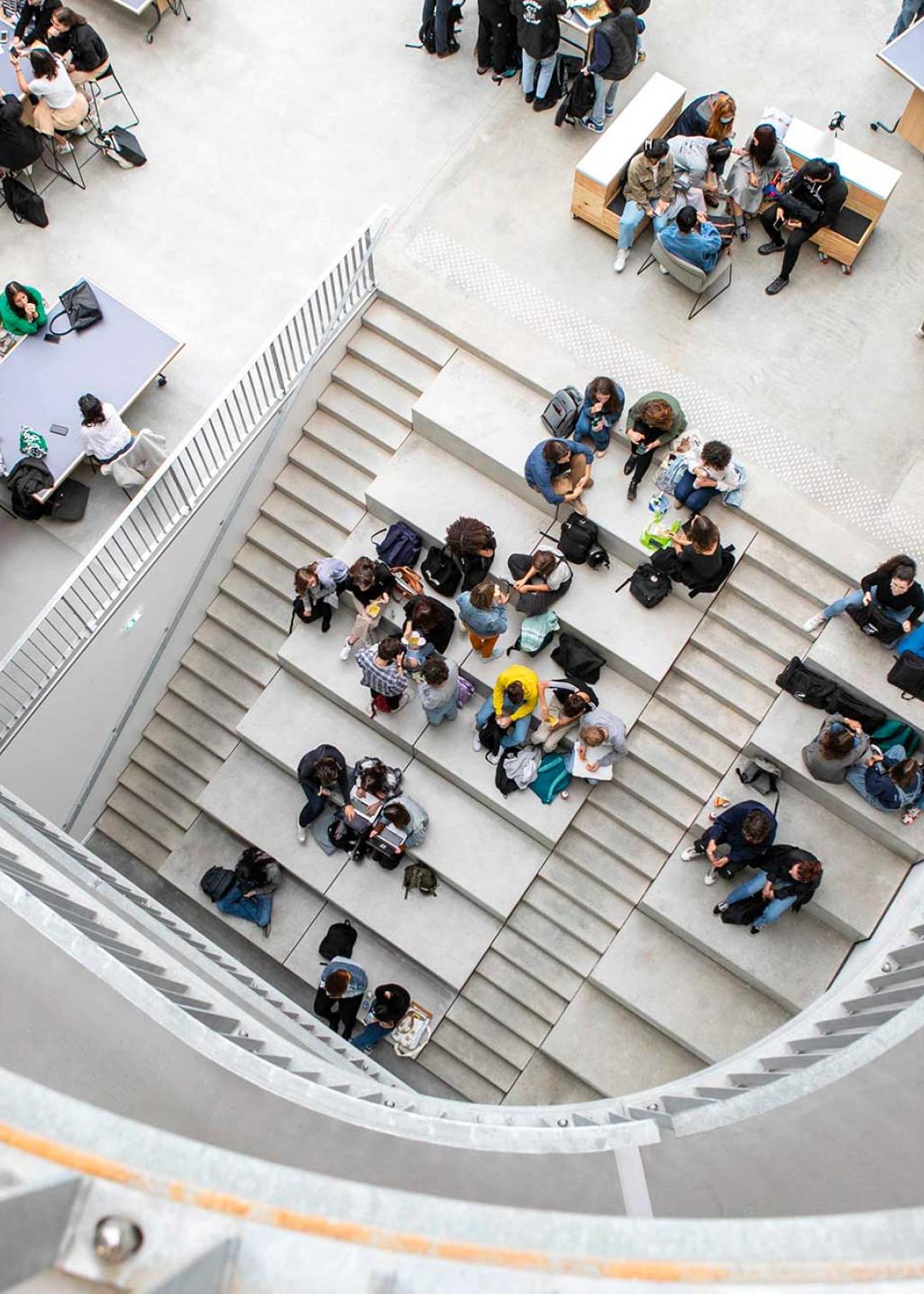
How to become a designer
Design careers
Becoming a designer is a dream for many creative people, but did you know that design plays an essential strategic role in innovation in the face of ongoing transitions (environmental, societal, technological...)? If you want to become a designer, you need to understand how to combine creativity and strategy so you can support the transformation of businesses and society!
What does it mean to be a designer? Working in design is much more than knowing how to draw or design aesthetic objects: it's above all a process of reflection and problem-solving. A designer seeks to understand user needs and design functional and aesthetic solutions, while taking into account technical, economic and environmental issues.
What is the designer's role?
- Design (objects, spaces, interfaces, visuals...) in a functional, sustainable and aesthetic way, to improve our daily lives today and invent the uses of tomorrow.
- Solve simple or complex problems faced by companies (technological and environmental challenges).
There are a lot of design fields such as product design, graphic design, digital design, space design, fashion design... There are many career opportunities in design, in a wide variety of fields.
The different fields of design
- Graphic design: Logos, visual identity, UI/UX, advertising
- Product design: Everyday objects, industrial innovation
- Space design: interior architecture, scenography
- Fashion and textile design: clothing, accessories, trends
- Digital design: video games, web interfaces, virtual reality
New professions are emerging today, such as service design and strategic design.
Why become a designer?
- Express your creativity and bring ideas to life
Design transforms a vision into reality by playing with shapes, colors, materials and technologies. Imagination and innovation are essential.
- Making an impact on people's daily lives
Whether in graphic design, product design, space design or UX/UI, the designer improves the user experience and makes objects, interfaces and environments more functional, aesthetic and pleasant to use.
- Combining aesthetics and functionality
Good design is about more than appearance: it serves a purpose and must meet specific needs. Becoming a designer means learning to balance aesthetics and utility.
- Working in a constantly evolving field
Design is a dynamic sector that evolves with trends, new technologies (such as AI and VR) and environmental and societal issues (eco-design, accessibility, sustainability). It's encouraging continuous learning.
- Varied opportunities and freedom
A designer can work for a company, an agency, freelance, or even create his or her own brand. The possibilities are numerous, and the profession often offers great flexibility and autonomy.
Qualities and skills of a designer
- Creativity & aesthetic sense
- Curiosity and visual culture
- Software skills (Photoshop, Illustrator, Sketch...)
- Adaptability and teamwork
- Problem-solving and critical thinking
Companies are increasingly recruiting multi-skilled designers, capable of adapting to different contexts, mastering a multitude of tools and techniques, working in project mode and federating teams...
L'École de design Nantes Atlantique takes a strategic view of design and trains innovation professionals capable of meeting the challenges of current and future transitions. Find out more
Design has become strategic
According to Christian Guellerin, executive director of the school, "designers are no longer just creative technicians, but have become the pre-eminent vectors of corporate development and strategy."
He explains that design has become strategic: "It's no longer about designing, producing and selling, today it's about giving meaning to everything that's designed, produced and sold. The world is being turned upside down by two radical changes in context: firstly, the climate crisis and the management of resources, and secondly, the new relationship between mankind and machines as robots become equipped with AI. The qestion "What will it mean to be human, when robots are smarter than we are?" is becoming paramount to all design work.
With their formidable ability to reconcile the arts and humanities, technology and marketing, designers draw and represent the new uses and needs of tomorrow, in order to make them a reality and give new meaning to progress.
Because design has become strategic, the designer has become a formidable conductor, a manager who guides companies and society in general towards ethical works, because a designer's job is not just to imagine the world but to build it."
The changing design approach in the face of major (r)evolutions
The world of design is booming, driven by two key transitions: the digital transition and the environmental transition. These profound upheavals are redefining the role of designers in organizations, and are paving the way for new strategic perspectives.
Being a designer today means facing up to strategic challenges and helping to shape the world of tomorrow. The designer's profession can be forged in a thousand and one ways, because it's a know-how built on a methodological foundation and a unique way of thinking and innovating. Buoyed by the revolutions taking place today, designers are taking on a more
strategic position within companies, and playing an essential role in the decisions to be taken.
This shift in design is based on three pillars: an accurate and detailed analysis of user behavior, and therefore of the experience to be created; the proper use of the technology available to us; and, finally, the need to give meaning and take into account CSR issues in their creations. The combination of all these skills supports the premise that designers are capable of taking their rightful place in organizations.
A growing demand for versatile designers
The demand for qualified designers is greater than ever, in a wide variety of fields. From industry to services to the public sector, designers are in demand for their creativity, their innovative spirit and their ability to conceive solutions that are both aesthetically pleasing, functional and meaningful.
The diversity of design professions requires designers to be highly versatile. They must be able to adapt to different contexts and master a multitude of tools and techniques. User experience (UX) has become an essential skill, as designers must now consider the entire user journey, from the interface to the overall experience of the product or space.
Bringing people and technology closer: the central role of
design
In an increasingly digitalized world, design plays a crucial role in adapting technology. It's not just about designing intuitive and accessible interfaces, it's about creating positive experiences and ensuring that technology is used responsibly and ethically.
Designers are at the heart of this essential mission. Able to understand users' needs, they translate them into concrete, genuinely useful proposals.
The environment: a critical issue for design
Designers must now integrate the sustainable dimension into their creations, by thinking about product life cycles and favoring environmentally-friendly materials and processes, but also and above all by asking the question "why". Designers act with a global, systemic vision of the issues at stake, taking into account the complexity of the upstream and downstream impacts of products and services.
Faced with the major upheavals our societies are going through, design is proving more than ever to be an essential discipline, at the crossroads between innovation, responsibility and meaning.
Driven by transitions, designers are called upon to play a central role in building a sustainable and desirable future. Their ability to understand needs, imagine solutions and shape experiences will be decisive in meeting the challenges of tomorrow's world. Far from being mere creators of objects or interfaces, designers are agents of transformation, visionaries capable of anticipating needs and building the contours of a better world
In the publication “All Designers”, L'École de design Nantes Atlantique highlights the inspiring career paths of 18 alumni to discover their vision of design in the face of technological, environmental and societal challenges.
Discover on this site the career paths of :
- Kevin Condette, Customer solutions architect
- Noémie Guirbert, Directrice retail & services
- Delphine Bagnol, food and services designer
- Batia Bertho, UX researcher

value and adapt to change

tomorrow's world
L'École de design Nantes Atlantique trains professionals in innovation who are in touch with real life and who must imagine the world of tomorrow in order to design its uses today.







